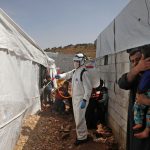Syria’s northwest – the country’s last rebel-held tract of territory – is facing a looming COVID-19 health catastrophe.
The immediate reason for the heightened health risk is the enormous number of people displaced by the Syrian conflict who now congregate in overflowing camps and congested towns. Over the past four months alone, nearly one million people have been displaced as a result of the Syrian government and Russia’s military campaign to re-take the area. The offensive has squeezed civilians into a shrinking area along the Turkish border, increasing the population density, stretching health services beyond their limits, and overwhelming humanitarian response efforts.
In the northwest regions of Idlib and western Aleppo, clinicians tell Physicians for Human Rights (PHR) that living conditions make the population highly susceptible to COVID-19.
“They are destitute. Their access to water is extremely limited. They are malnourished. They haven’t had decent health care in nine years. And they are under constant and extreme stress,” said Ahmad Dbeis, a health professional working on northwest Syria with the Union of Medical and Relief Organizations. “God forbid we see a spread of the (COVID-19) illness in the area. It would be an absolute disaster.”
But there’s another reason why people in Syria’s northwest are at a particularly high risk of an uncontrollable outbreak of the novel coronavirus. Over the past five years, the Syrian government and Russia have deliberately and systematically eviscerated the region’s health care infrastructure through targeted bombing and shelling. Since the beginning of the Syrian conflict in 2011, PHR has been documenting attacks on health facilities and health workers, most of which were perpetrated by the Syrian government and its allies. Of the 595 attacks we have documented since 2011, 312 hit hospitals, clinics, and other medical units in the governorates of Idlib and Aleppo. Over the past year alone, the Syrian government and Russia have carried out at least 40 attacks on health facilities in the northwest as part of their campaign to recapture the enclave.
“They are destitute. Their access to water is extremely limited. They are malnourished. They haven’t had decent health care in nine years. And they are under constant and extreme stress.”
Ahmad Dbeis, a health professional working on northwest Syria
That systematic assault on medical facilities has left the health system barely able to respond to existing needs. With so many hospitals damaged beyond repair over the past year, some health workers and humanitarian aid providers in Idlib and west Aleppo worry that any effort to expand the medical system’s capacity would be a losing battle. According to Dr. Munther al-Khalil, head of the Idlib Health Directorate, Idlib now has only one hospital bed for every 1,592 people – five times less than the number of hospital beds per capita in Italy. Hospitals in all of northwestern Syria, an area with an estimated population of more than four million people, are operating with a total of 201 intensive care beds and 95 adult ventilators. Of those, not a single bed or ventilator is currently available, said Dr. Munther.
To date, no COVID-19 cases have been confirmed in Idlib or western Aleppo. The handful of suspected cases that have been tested in the central laboratory in the city of Idlib have all come back negative, according to local sources. But across the line in government-controlled territory, cases have started popping up – an extremely worrying development, given the level of destruction and displacement the Syrian government and its allies have inflicted on most regions in the country. Despite the closure of all crossing points between government- and rebel-held areas, authorities in the northwest still fear that the virus will make its way into their area – if it’s not already there.
That prospect is alarming. We have seen how well-resourced countries with well-functioning health systems – Italy, and now parts of the United States – are being overwhelmed by the pandemic. In Syria, where the population’s vulnerability to the illness is inextricably linked to the Syrian government’s deliberate destruction of medical facilities and forced population displacement, the outlook is extremely grim.
In Syria, where the population’s vulnerability to the illness is inextricably linked to the Syrian government’s deliberate destruction of medical facilities and forced population displacement, the outlook is extremely grim.
In order to be able to mitigate the impact of a potentially widespread contagion, the northwest of Syria desperately needs more hospital beds, more functional intensive care units, more medical equipment and supplies, from ventilators, to oxygen, medication, and personal protective gear. But the most crucial component of the impending battle against the coronavirus is a lasting cessation of hostilities. While the recent Russian-Turkish ceasefire seems to be holding, it remains very fragile. There is no chance the area can confront the pandemic should the bombs start falling again.
Without a sustainable, nationwide ceasefire, all other actions to counter coronavirus in northwest Syria are likely to fail, adding a potentially catastrophically high death toll to a conflict that has already claimed hundreds of thousands of civilian lives.

